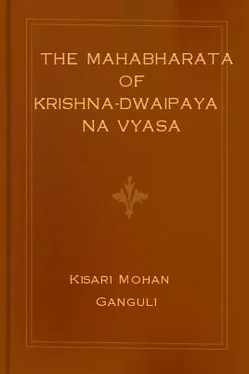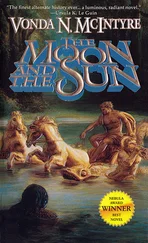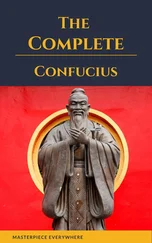Kisari Mohan Ganguli - The Mahabharata of Krishna-Dwaipayana Vyasa
Здесь есть возможность читать онлайн «Kisari Mohan Ganguli - The Mahabharata of Krishna-Dwaipayana Vyasa» весь текст электронной книги совершенно бесплатно (целиком полную версию без сокращений). В некоторых случаях можно слушать аудио, скачать через торрент в формате fb2 и присутствует краткое содержание. Издательство: ManyBooks.net, Жанр: на английском языке. Описание произведения, (предисловие) а так же отзывы посетителей доступны на портале библиотеки ЛибКат.
- Название:The Mahabharata of Krishna-Dwaipayana Vyasa
- Автор:
- Издательство:ManyBooks.net
- Жанр:
- Год:неизвестен
- ISBN:нет данных
- Рейтинг книги:3 / 5. Голосов: 1
-
Избранное:Добавить в избранное
- Отзывы:
-
Ваша оценка:
- 60
- 1
- 2
- 3
- 4
- 5
The Mahabharata of Krishna-Dwaipayana Vyasa: краткое содержание, описание и аннотация
Предлагаем к чтению аннотацию, описание, краткое содержание или предисловие (зависит от того, что написал сам автор книги «The Mahabharata of Krishna-Dwaipayana Vyasa»). Если вы не нашли необходимую информацию о книге — напишите в комментариях, мы постараемся отыскать её.
The Mahabharata of Krishna-Dwaipayana Vyasa — читать онлайн бесплатно полную книгу (весь текст) целиком
Ниже представлен текст книги, разбитый по страницам. Система сохранения места последней прочитанной страницы, позволяет с удобством читать онлайн бесплатно книгу «The Mahabharata of Krishna-Dwaipayana Vyasa», без необходимости каждый раз заново искать на чём Вы остановились. Поставьте закладку, и сможете в любой момент перейти на страницу, на которой закончили чтение.
Интервал:
Закладка:
372. For without ghee, which is produced from milk, there can be no sacrifice. The sa may refer to Soma, but sacrifice is evidently meant.
373. The idea of uchcchishta, is peculiarly Hindu and cannot be rendered into any other language. Everything that forms the remnant of meal after one has left of eating, is uchcchishta. The calf sucks its dam. The udders, however, are not washed before milking the dam, for the milk coming out of them is not held to be impure remnant.
374. Swastayana is a ceremony of propitiation, productive of blessing and destructive of misery of every kind.
375. The commentator explains that by a wet cowhide is meant a piece of cowhide that has been dipped in water and thus purified. Upavisya is understood after Charmani. The mention of bhumau implies the avoidance of dishes or plates or cups of white brass or other allowable metals. Gavam pushtim, I understand, means 'the prosperity in respect of kine.' i.e., the prosperity which kine confer.
376. The first line of verse 4 seems to be connected with verse 3. The second line of 4 seems to stand by itself. By connecting the first line of 4 with the second, the meaning will be--All mobile and immobile creatures that will give us away etc. Immobile creatures making gifts of kine would be utter nonsense.
377. Vallaki is the Indian lute. The Nupura is an ornament for the ankles.
378. Bhumidah is literally, a giver of land. King Saudasa, the commentator explains, was known by the name of Bhumidah in consequence of his liberality in the matter of giving away land unto the Brahmanas.
379. These are the several names by which kine are known. The first is probably derived from kine bearing the plough and thus assisting the tillage of the soil. The second implies beauty of form. The third is derived from the cow being regarded as the origin of all things in the universe: all things, therefore, are only so many forms of the cow. Viswarupa implies the same thing. Matara implies mothers, kine being regarded as the mothers of all.
380. Ghee is regarded so sacred because of its use in sacrifices. It is with the aid of ghee that the deities have become what they are. Itself sacred, it is also cleansing at the same time.
381. Sri is the goddess of Prosperity. The answer of Bhishma will explain the question fully.
382. Devendreshu is evidently a misreading for Daitendreshu.
383. The commentator explains that hence, by making gifts of gold, one comes to be regarded as making gifts of the entire universe.
384. i.e., into water, for water is identical with Agni.
385. This refers to the practice of making the sacrificial fire by rubbing two sticks of Sami. It is a very inflammable wood and is used hence in all sacred rites.
386. Hiranyaretas implies having gold for his vital seed.
387. Vasumati implies endued with wealth, so called because the seed of Agni, identified with gold, is wealth of the highest kind and fell on the Earth who from that time began to hold it.
388. Skanda is derived from Skanna or fallen out. Guha implies secret. The secrecy of his birth in the wilderness led to the bestowal of this name. He has many other names.
389. Jatarupa refers to the incident of its having assumed an excellent form after its birth from Agni.
390. The commentator explains,--Pravrittipradhanam jangamamabhut.
391. Sa guna refers to Sattwa. Tejas is identical with Buddhi, because Buddhi, like Light, discovers all things. Sattwa, again, being of the nature of space, or rather being space itself, is of universal form; that is, Sattwa is all-pervading.
392. Avasatmaka is explained by the commentator as bhranta.
393. These are different names of Brahman and Mahadeva.
394. The 'hence' here does not refer to what preceded immediately, but has reference to what has been said of the identity of Agni with Brahman and Rudra.
395. Pravartakam implies leading to Pravritti for righteous acts or Chittasuddhi.
396. The commentator explains that the Pitris should be worshipped on the day of the New moon, the deities should then be worshipped on the first day of the lighted fortnight. Or, on any other day of the lighted fortnight, the Pitri-sacrifice or Sraddha should be performed first; the Deva-sacrifice or Ishti should then be performed.
397. Anwaharyam, the commentator explains, is paschatkartavyam, i.e., subsequently performable (subsequent, i.e., to the worship of the gods). There is a special ordinance, however, which lays down that the Sraddha should be performed on the afternoon of the day of the new moon. The gods should be adored on the first day of the lighted fortnight. Hence, owing to this especial ordinance, the Sraddha must precede the worship of the gods, and not succeed it.
398. Masha, is the Phascolus Roxburghii.
399. It is difficult to understand what is meant by Vadhrinasa here. It means either a large bull, or a kind of bird, or a variety of the goat. Probably the bull is intended.
400. Pitrikshaye is mrita-tithau. Kalasaka is explained by Nilakantha as identical with the common potherb called Shuka or the country sorrel (Rumex visicarius, Linn). Some hold that it is something like the sorrel, Lauham is the petals of the Kanchana flower (Bauhinia acuminata, Linn).
401. To this day the sanctity of Gaya is universally recognised by all Hindus. Sraddhas are performed there under the banian called the Akshaya or inexhaustible banian.
402. All religious acts are either nitya or kamya. The former imply acts that are obligatory and by doing which no particular merit is acquired but by not doing which sin is incurred. The latter imply those optional acts which, if done, produce merit but which, if omitted, leads to no sin.
403. Literally, 'set in motion a body of kings,' i.e., become an Overlord."
404. When Brahmanas are fed, they are made to sit in long lines. They that are stained with vices are excluded from the line. Such exclusion from the line is regarded as equal to complete outlawry.
405. i.e., who have undergone a natural circumcision
406. Implying soothsayers.
407. This is a common form of expression to imply the fruitlessness of an act. Libations should be poured on the blazing fire. If poured on the ashes, they lead to no merit, for only Agni in his blazing form can bear them to the intended places.
408. The idea is that heaven is the result of one's deeds. It is attached to the fruits of one's acts. The man falling off from heaven is identical with heaven being dissociated from the fruits of his acts. Hence such a falling off at the man or the dissociation of heaven is likened to a bird's dissociation from its perch when the chain tying it to the perch is broken. The simile seems to be far-fetched.
409. It is painful to see how very careless the Vernacular versions of the Anusasana have been. From want of space the numerous errors that have been committed have not been pointed out, At times, however, the errors appear to be so grave that one cannot pass them by in silence. In the second half of the first line, whether the reading be avapta as in the Bengal texts or chavapta as in the Bombay texts, the meaning is that the Avapta or one that has not sown na vijabhagam prapnuyat, i.e., would not get a share of the produce. The Burdwan translators make a mess of it, while K. P. Singha skips over it.
410. The sense is that the calumniator, his sire, and son meet with destruction in consequence of such an act.
411. These purificatory rites, after the usual period of mourning, consists in shaving and bathing and wearing new clothes.
412. The act, as explained by the commentator, consisted in the father's doing that with reference to the son which, as the ordinance went, was done by sons with reference to sires.
413. In one of the vernacular versions, the wrong reading Kshama is adopted for Akshaya.
Читать дальшеИнтервал:
Закладка:
Похожие книги на «The Mahabharata of Krishna-Dwaipayana Vyasa»
Представляем Вашему вниманию похожие книги на «The Mahabharata of Krishna-Dwaipayana Vyasa» списком для выбора. Мы отобрали схожую по названию и смыслу литературу в надежде предоставить читателям больше вариантов отыскать новые, интересные, ещё непрочитанные произведения.
Обсуждение, отзывы о книге «The Mahabharata of Krishna-Dwaipayana Vyasa» и просто собственные мнения читателей. Оставьте ваши комментарии, напишите, что Вы думаете о произведении, его смысле или главных героях. Укажите что конкретно понравилось, а что нет, и почему Вы так считаете.












